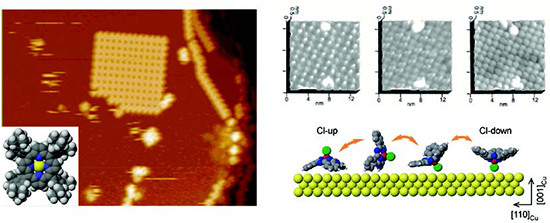Журнал "Макрогетероциклы"
Журнал является форумом специалистов, изучающих макрогетероциклические соединения
Navigation
News
Impact Factor 2021 = 1.200 has been issued by ISI Web of Knowledge (JCR 2021).
Search
ISSN 1998-9539
Molecular Imaging of Macroheterocycles for Demonstration of Classical Nucleation and Quantum Switching
Hisao Yanagi
Graduate School of Science and Technology, Nara Institute of Science and Technology, 8916-5 Takayama, Ikoma, 630-0192 Nara, Japan
E-mail: yanagi@ms.naist.jp
Dedicated to Professor Dieter Wöhrle on the occasion of his Birthday
DOI: 10.6060/mhc190769y
Macroheterocycles 2019 12(3) 244-254
Single molecular imaging by scanning tunneling microscopy (STM) was carried out for platinum tetra(3,5-di-tert-butylphenyl)porphyrin (Pt-TBPP) and chloro[subphthalocyaninato]boron(III) (SubPc) adsorbed on Cu (001) surface under ultrahigh vacuum. In the former, two-dimensional nucleation growth of Pt-TBPP assemblies was demonstrated according to classical thermodynamic mechanism. The registry of Pt-TBPP molecules into the kink sites minimized the free energy for nucleation resulting in formation of singular nuclei with rectangular shapes. In the latter, STM-induced flip-flop switching was molecularly visualized for epitaxially adsorbed SubPc arrays. The asymmetric SubPc molecules initially adsorbed with its axial chlorine atom either upwards or downwards. After scanning at a negative bias, the upward molecules turn upside down while all molecules switched to the upward orientation at a positive bias. This orientational switching is not consistent with that expected from the polarity of the SubPc molecule along the Cl-B bond. Moreover, similar switching phenomena were observed during continuous scanning at a constant bias. Molecular energy calculation and statistical thermodynamic evaluation concluded that the tip-triggered fluctuation in the close-packed SubPc array induced the molecular rearrangement with stochastic flip-flop switching. This stochastic behavior suggests that the switching is not a single molecular event but is more related to intermolecular entanglement among arrayed molecules which envisages us to consider molecular-based quantum phenomena.

| Attachment | Size |
|---|---|
| mhc190769y.pdf | 4.43 MB |
- 1178 reads
- Русский
